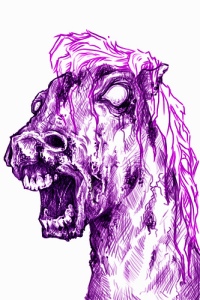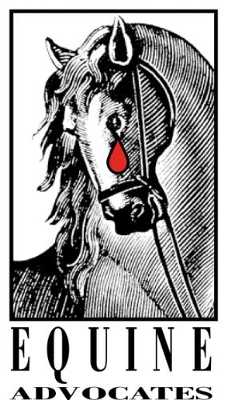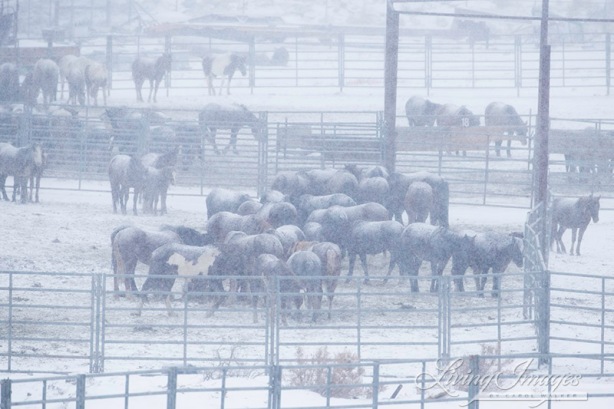Straight from the Horse's Heart
“I was growing more upset by the moment as donkey after donkey appeared to surround us displaying various levels of medical or nutritional needs…”
On Tuesday March the 11th, I paid a visit to the Donkey Sanctuary Bonaire. I was looking forward to the visit, and came with an open mind hoping that what I heard from the locals was simply exaggerated and could be fixed easily. What I found, was much worse. I found donkeys in dire need of adequate food, shelter, medical care, and simple maintenance.
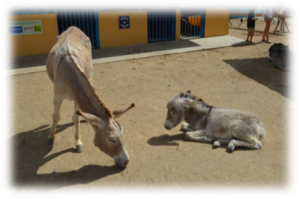 After speaking to the Sanctuary supervisor, at the entrance I was startled to learn that they had killed (“only”) 68 donkeys since November out of 138 gathered. The supervisor said “only” as if this word justified the killing. She claims that they all had tetanus and various other medical problems that made it necessary to send them to the landfill. She also claimed there is no cure for tetanus, which is untrue. If caught in time, a heavy dose of penicillin or anti-toxin at maximum strength offers hope to the stricken donkey. She went on to describe how the Bonairean people did not care about the donkeys, and that they had set them on fire, stoned them, wrapped them in barbed wire and did other cruel things to them. When I asked her if she had reported these things, she said, “no, the police don’t care, no one cares about the donkeys in Bonaire.” This did not ring true since I had been meeting with many Bonaireans who were clearly upset at what was happening to their donkeys. So, it seems the Donkey Sanctuary Bonaire is slandering the native people of this island in order to gain financially from the sympathy they garner with these false statements. This is a sad way to secure donations, in my view.
After speaking to the Sanctuary supervisor, at the entrance I was startled to learn that they had killed (“only”) 68 donkeys since November out of 138 gathered. The supervisor said “only” as if this word justified the killing. She claims that they all had tetanus and various other medical problems that made it necessary to send them to the landfill. She also claimed there is no cure for tetanus, which is untrue. If caught in time, a heavy dose of penicillin or anti-toxin at maximum strength offers hope to the stricken donkey. She went on to describe how the Bonairean people did not care about the donkeys, and that they had set them on fire, stoned them, wrapped them in barbed wire and did other cruel things to them. When I asked her if she had reported these things, she said, “no, the police don’t care, no one cares about the donkeys in Bonaire.” This did not ring true since I had been meeting with many Bonaireans who were clearly upset at what was happening to their donkeys. So, it seems the Donkey Sanctuary Bonaire is slandering the native people of this island in order to gain financially from the sympathy they garner with these false statements. This is a sad way to secure donations, in my view.
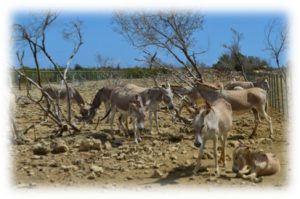 I arrived with two guests, prior to the sanctuary opening their gate at 10 a.m. Once we were allowed in, we visited the brightly painted and very neatly kept gift shop. Everything seemed copacetic as we paid an entry fee and entered into the next area which was the enclosure for the sick, babies and new mothers. Here she had a small building and a simple roof shelter to protect this group of donkeys. As I walked through, I noted that the stalls intended for the very sick allowed all the donkeys in the yard to come and muzzle the patient inside the stall. Should that patient have had any illness such as strangles or the flu, an epidemic would start that would result in a loss of many lives. One of the few stalls available was actually being used for storage instead of needed medical space. Since the only vaccines that are given, according to the supervisor, are tetanus shots every eight years all of the donkeys are at risk should an outbreak of illness occur. These donkeys are pushed into unnaturally close proximity to each other now stand unprotected from all of the new donkeys being added to the population without quarantine. I was shocked. It is standard sanctuary practice to quarantine for a minimum of 14 days prior to introduction of new members to a herd.
I arrived with two guests, prior to the sanctuary opening their gate at 10 a.m. Once we were allowed in, we visited the brightly painted and very neatly kept gift shop. Everything seemed copacetic as we paid an entry fee and entered into the next area which was the enclosure for the sick, babies and new mothers. Here she had a small building and a simple roof shelter to protect this group of donkeys. As I walked through, I noted that the stalls intended for the very sick allowed all the donkeys in the yard to come and muzzle the patient inside the stall. Should that patient have had any illness such as strangles or the flu, an epidemic would start that would result in a loss of many lives. One of the few stalls available was actually being used for storage instead of needed medical space. Since the only vaccines that are given, according to the supervisor, are tetanus shots every eight years all of the donkeys are at risk should an outbreak of illness occur. These donkeys are pushed into unnaturally close proximity to each other now stand unprotected from all of the new donkeys being added to the population without quarantine. I was shocked. It is standard sanctuary practice to quarantine for a minimum of 14 days prior to introduction of new members to a herd.
As I walked around in this enclosure I noted that the donkeys seem depressed and defeated, and many had diarrhea. One baby had vet wrap applied directly to his leg, minus any barrier of cotton beneath which will, of course cause tremendous irritation. I also noted that the area was full of stones and debris no one bothered to remove which offered few places of relative comfort to lie down. Because no precautions had been taken to wrap the native trees in such a confined area the foliage was stripped bare giving the impression of a bone yard. I enjoyed hugging the babies and scratching their itchy bottoms very much. Baby donkeys are the cutest animal in the world, in my opinion. And these seemed to be in fairly good shape although they had very low energy for babies. However, I was most concerned that they were placed next to the stalls meant for the sick without consideration for the spread of disease. In addition to the unusually low energy displayed by the babies I also noted that the jennies (females) also appeared to lack energy even though this was early in the day.
The next part of the visit was by car through the 140 acre “sanctuary”. The barren earth was testament to the overcrowding as swarms of donkeys approached the truck we were in. We began to take note of a large number of very thin and emaciated donkeys mixed with healthier, stronger donkeys all vying for attention as they came in front of our vehicle forcing us to a stop. As I looked closer at these forlorn beggars I noted many skin disorders, including many who displayed signs of mineral imbalances and deficiencies. There were several donkeys losing hair on their tails and mane areas which is an indicator of a mineral imbalance or deficiency. Many had wounds that could have been ringworm, mites or lice and I saw several eating dirt and manure which is called Pica a behavior displayed when nutritional needs are not being met.
It troubled me greatly with my experience as the equine manager overseeing more than 400 donkeys, mules and horses that people were allowed and encouraged to bring their own food to feed to the donkeys. There was no oversight or instruction as to what might harm the donkeys if it were fed to them. And, knowing donkeys as I do, I was alarmed that people were being encouraged to bring food inside the enclosure to feed to the donkeys when I know how competitive they can be for treats, especially when they are hungry. No one from the sanctuary was present to monitor the guests as they toured the sanctuary. This lack of oversight could lead to injury to a guest or one of the donkeys.
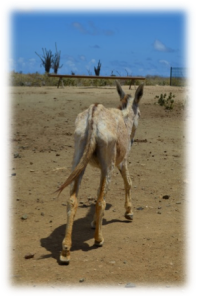 We had arrived before the gate opened, so when it opened at 10 am they should have still had hay available to eat in their hay racks. The approximately 20 small hay racks that I saw were all void of hay, and I did not see a round bale any easily accessed hay anywhere to provide healthy forage to these donkeys throughout the day on this completely barren land. It was shocking really. Alarmingly, I did not see any kind of shelter in this enclosure of dirt and rock. Nor was there any kind of natural protection such as what they would seek out in the wild. The fact that they are desert animals well suited to arid climates and soils does not mean that they can go without shelter. In the wild they seek shelter such as cliff edges, gullies or trees. At the “Sanctuary” they are left to the elements.
We had arrived before the gate opened, so when it opened at 10 am they should have still had hay available to eat in their hay racks. The approximately 20 small hay racks that I saw were all void of hay, and I did not see a round bale any easily accessed hay anywhere to provide healthy forage to these donkeys throughout the day on this completely barren land. It was shocking really. Alarmingly, I did not see any kind of shelter in this enclosure of dirt and rock. Nor was there any kind of natural protection such as what they would seek out in the wild. The fact that they are desert animals well suited to arid climates and soils does not mean that they can go without shelter. In the wild they seek shelter such as cliff edges, gullies or trees. At the “Sanctuary” they are left to the elements.
I wanted to find the water source for these donkeys so we drove through the opening of the first large enclosure containing bare dirt into the second large enclosure which remained opened allowing the donkey’s access to both. The second open enclosure had a large fenced off building that the donkeys could not access unless personnel opened the gate. As we drove through we found more painfully thin donkeys and some kind of a tall weed that they would not eat. In this enclosure should a donkey get sick and die they would never know.
The supervisor we spoke to when we first arrived made it clear that the small animal veterinarian is not called for most illnesses. She said they cannot afford a veterinarian. Generally, the veterinarian is only called for euthanasia of animals they don’t feel they can afford to treat, and for castration of the intact jacks that are being brought in due to the $20.00 bounty she is offering for each. I did learn at a recent meeting with Island council that they were euthanizing the donkeys for mange and old age, a practice they have been asked to stop.
The fact that any animals were euthanized because they had a treatable mite infestation is really cruel. But, I am even more disturbed that the herd knowledge held by the seniors is not recognized. Without the seniors the youngsters lack guidance. The seniors know how to stay safe, they know where to find water during dry spells, and they control population growth with an understanding of the conditions on the island that allow for plant growth. It is an egregious error to not recognize the importance of the senior donkeys to the health of the herd as a whole. Fortunately, it is my understanding is that they are no longer allowed to kill the old donkeys who come into the sanctuary, but it is suspicious that the old ones are castrated and turned out in areas where there is absolutely no chance they will find water.
Castration of males at the “sanctuary” is carried out by a local small animal veterinarian and based on reports from the local Bonaireans some are being found dead in their fields. I am not surprised since castration of donkeys is extremely dangerous even with the skilled hands of a large animal veterinarian performing the surgery. My veterinarian explained to me that because donkeys have a much larger vascular blood supply running through the scrotum area they must be ligated and stitched after surgery. Additionally, great care must be taken with anesthesia since donkeys often have an adverse reaction to these drugs. Therefore, he keeps donkeys under supervision for a week to watch for infection or bleeding before he feels they are safely on the road to recovery. This is important since it is not unusual for donkeys to blowout stitches which will result in them bleeding out. The Donkey Sanctuary Bonaire castrates donkeys, and within 24 hours they are tagged and released into areas where they are often unable to gain access to food or water. I came across a thirsty elderly recently castrated male in the middle of the Cargill salt processing area. His tongue was hanging out, and he seemed very weak although his body condition was fair.
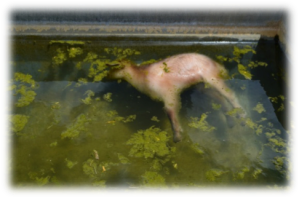 I was growing more upset by the moment as donkey after donkey appeared to surround us displaying various levels of medical or nutritional needs. Eventually, we finally found the fresh water source for the donkeys, but we also ran into an unpleasant surprise. Inside the straight-sided water tank floated a dead baby goat. The water was full of algae, and no wildlife ladder was present inside the tank. A carcass floating in the water posed the risk of infecting everyone with botulism as well as a whole host of other infectious diseases. When we informed the personnel at the front that there was a dead goat in the water, the response we got was, “again!” Knowing that they are in an arid country where other wildlife would seek out this water source should have alerted them that a wildlife ladder was needed in the tank.
I was growing more upset by the moment as donkey after donkey appeared to surround us displaying various levels of medical or nutritional needs. Eventually, we finally found the fresh water source for the donkeys, but we also ran into an unpleasant surprise. Inside the straight-sided water tank floated a dead baby goat. The water was full of algae, and no wildlife ladder was present inside the tank. A carcass floating in the water posed the risk of infecting everyone with botulism as well as a whole host of other infectious diseases. When we informed the personnel at the front that there was a dead goat in the water, the response we got was, “again!” Knowing that they are in an arid country where other wildlife would seek out this water source should have alerted them that a wildlife ladder was needed in the tank.
We also visited a tower that had been recently constructed to provide visitors a means to climb up and look around at the sanctuary from a different perspective. There was some shelter provided underneath of it, but certainly not enough to accommodate all 400 donkeys at the sanctuary. As I looked down from the height of the tower, I realized that we had come across a feeding area. The donkeys were being fed cardboard. It was awful to witness as they pushed each other away to get to the “food” their bodies so desperately needed. Not only does the cardboard lack nutritional value, this cardboard was dyed various colors which meant the donkeys were being fed harmful chemicals.
Then, a yearling jenny appeared at our window with a very swollen cheek. I did not examine inside her mouth so I could not tell the source of her problem. It certainly needed attention from a veterinarian in my opinion. My suspicion was that it was a dental issue that should be addressed. I felt very disheartened to leave her and many of the others there, knowing they were more than likely not going to get the care they needed. So many were so thin, they soon would become recumbent since they were not separated from the stronger ones to eat. By this time, my heart was already breaking as I felt their hopelessness. It shook me to the core to witness what I witnessed at this “sanctuary” from hell.
Just when I thought I had seen the worst of it, I saw the feed ration for the evening and realized it was only enough for 50-75 donkeys. Included in their ration for the evening were fruits and vegetables collected for the donkeys. These are nutritional and I am sure the donkeys loved getting them. However, there were also extremely hot peppers in the mix too, and many fruits and vegetables that were very rotten. I had to leave at this point.
It was clear to me that many of the sweet faces I saw on Tuesday would not be there for very long. Their condition is deteriorating rapidly with no relief in sight. How sad that these once healthy wild donkeys were “saved from the people of Bonaire” so that they could be brought to this concentration camp to die. To read Ms. Melis’ facebook page, one would believe that the people of Bonaire are cruel and uncaring. Nothing could be further from the truth.
The people of Bonaire need a sanctuary where the injured, weak, and nuisance donkeys can be brought for care. There is a place for a properly run, well managed sanctuary here. The Bonaireans believed that Ms. Melis was going to provide that care. What they did not realize was that her plan went beyond the injured, weak, and nuisance donkeys and morphed into a plan in which she would control the entire population of Bonaire’s donkeys. It was confirmed at the island council meeting that breeding at the sanctuary would occur there, and all the wild donkeys would be gone in 10 years’ time. The insanity of it all is that the present management of Bonaire Donkey Sanctuary cannot care for the ones she has much less take in more. It begs the question, why? My answer is incompetence and a need for a professional to take over the duties of the sanctuary.
It defies logic to save those who do not need to be saved, lock them up, and then manage them with a complete lack of care. This is called hoarding when a person collects and “saves” animals they cannot care for properly. I would argue these donkeys need to be saved from her. My heart is broken.
Marjorie Farabee, equine manager
Todd Mission Ranch
Home to: TMR Rescue, Inc.
After many years of operation, Todd Mission Ranch realized the need to offer a safe landing for equine who found themselves in unsafe situations. So we opened TMR Rescue, Inc. to care for those that we could. We are now caring for over 400 donkeys, mules and horses with 90% of those being donkeys. I have been the equine manager for 8 years. We are always happy to provide tours should anyone request it. We enjoy showing off our extended family.
As for speaking to the issue of the wild burros of Bonaire, I have been involved with the wild burro issues in the USA for 7 years. My work has taken me into the field where I have studied their behavior and I have accumulated mountains of research on burros (donkeys) and their habitats. I am frequently asked to speak at events including the upcoming International Equine Conference held in Wellington FL in Sept of this year. I am now on the board of directors with Wild Horse Freedom Federation and act as Director of Wild Burro Affairs with this organization. In addition, I am the President of Wild Burro Protection League. In 2012 we were successful in gathering 113,000 signatures to stop Texas Parks and Wildlife Department from shooting wild burros. This petition has now accumulated over 138,000 signatures, which I believe speaks to the value of donkeys to people. Those who love them love them deeply. Please consider the eradication of Bonaire’s donkeys as the assault that it is on the environment, the culture, and the psychology of the people of Bonaire. It is a decision that could have deep consequences to all concerned. The donkeys are an asset, and if they are promoted and treated as such, respect for them will follow.






